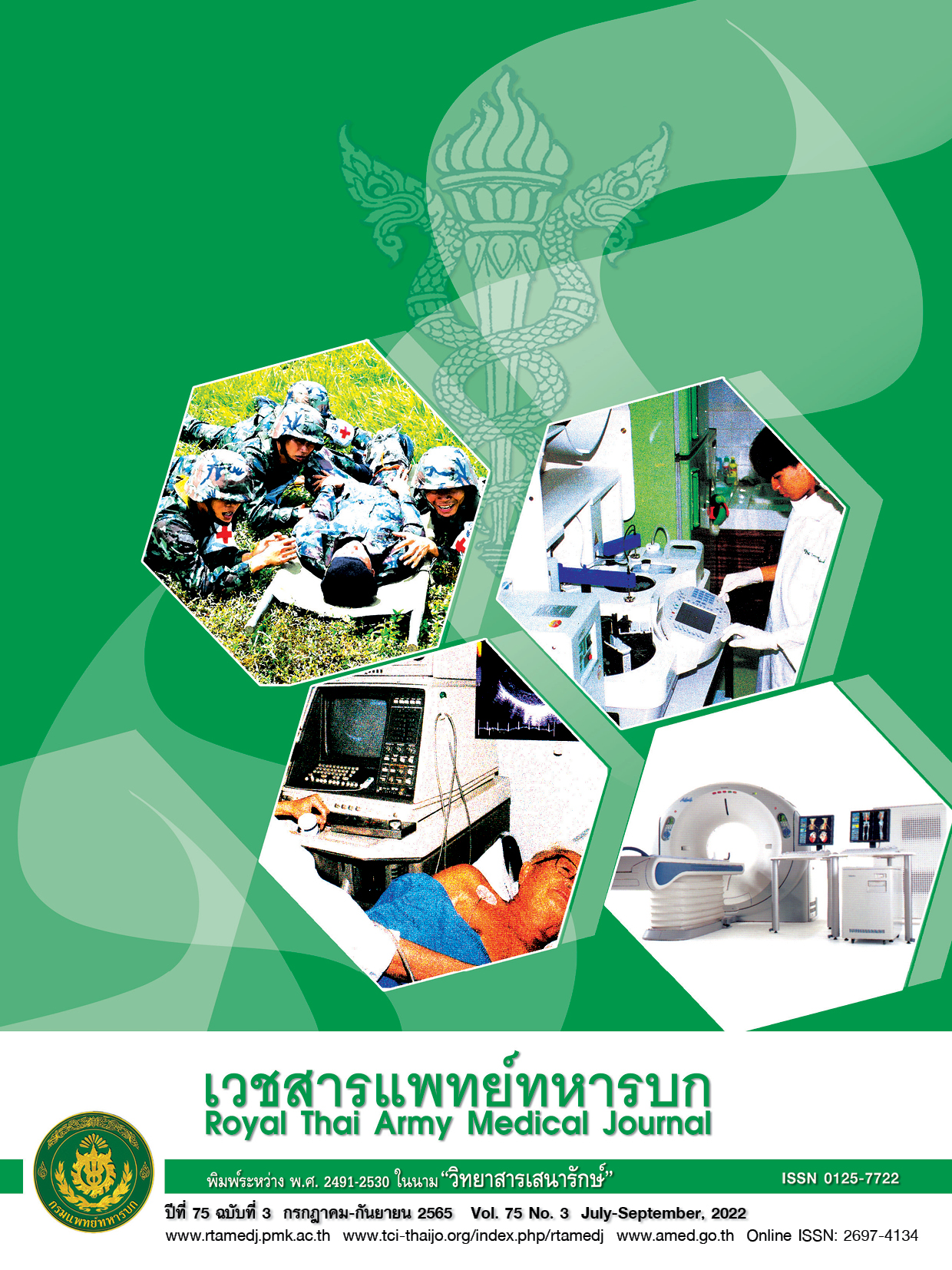ความสัมพันธ์ระหว่างการให้อาหารทางหลอดเลือดดําผ่านทางหลอดเลือดดําส่วนปลาย และการติดเชื้อราแคนดิดาในกระแสเลือด
Main Article Content
บทคัดย่อ
บทนำ : การติดเชื้อราแคนดิดาในกระแสเลือดพบได้บ่อยโดยมีอัตราการเสียชีวิตมากถึงร้อยละ 40 โดยมีปัจจัยเสี่ยง อาทิเช่น ได้รับยาปฏิชีวนะเป็นเวลานาน ได้รับการใส่สายสวนในหลอดเลือดดำใหญ่ และการให้สารอาหารทางหลอดเลือดดำ เป็นต้น อย่างไรก็ตาม การศึกษาหาปัจจัยเสี่ยงส่วนใหญ่ได้ทำการศึกษาโดยให้สารอาหารทางหลอดเลือดดำผ่านทางหลอดเลือดดำใหญ่ จึงเป็นคำถามของการวิจัยนี้
วัตถุประสงค์ : เพื่อศึกษาความสัมพันธ์ระหว่างการให้อาหารทางหลอดเลือดดำผ่านทางหลอดเลือดดำส่วนปลายและการติดเชื้อราแคนดิดาในกระแสเลือด ในผู้ป่วยที่นอนโรงพยาบาล
วิธีดำเนินการวิจัย : การศึกษาจับคู่โรคโดยเก็บข้อมูลจากหอผู้ป่วยหนัก ในโรงพยาบาลพระมงกุฎเกล้า ตั้งแต่ 1 มกราคม 2559 ถึง 30 กันยายน 2563 โดยเก็บข้อมูลที่ต้องการศึกษาวิเคราะห์ผ่านโปรแกรมSTATA14
ผลการวิจัย : มีผู้ป่วย 42 คน ในกลุ่มโรค และ 84 คน ในกลุ่มควบคุม โดยมีอายุเฉลี่ย 65 ปี โดยปัจจัยเสี่ยงของการติดเชื้อราแคนดิดาในกระแสเลือดได้แก่ การผ่าตัดช่องท้อง/ช่องอก OR 4.61 (p-value 0.005) การได้รับยาปฏิชีวนะเป็นเวลานาน OR 5.01 (p-value 0.015) การได้รับสารอาหารทางหลอดเลือดดำรวมผ่านทุกช่องทาง OR 2.20 (p-value 0.041) และการได้รับสารอาหารผ่านทางหลอดเลือดดำใหญ่ OR 3.46 (p-value 0.034), การได้รับสารอาหารทางหลอดเลือดดำผ่านทางหลอดเลือดดำส่วนปลายเทียบกับการให้ผ่านทางหลอดเลือดดำใหญ่สัมพันธ์กับการติดเชื้อราแคนดิดาในกระแสเลือดไม่ต่างกัน (HR 0.88 , p-value 0.78)
สรุปผลการวิจัย : จากการศึกษาพบว่าการผ่าตัดช่องท้อง/ช่องอก การได้รับยาปฏิชีวนะเป็นเวลานาน การได้รับสารอาหารทางหลอดเลือดดำรวมผ่านทุกช่องทาง และผ่านทางหลอดเลือดดำใหญ่ สัมพันธ์กับการติดเชื้อราแคนดิดาในกระแสเลือด แต่การได้รับสารอาหารผ่านทางหลอดเลือดดำส่วนปลายไม่สัมพันธ์กับการติดเชื้อราแคนดิดาในกระแสเลือด นอกจากนั้นการได้รับสารอาหารทางหลอดเลือดดำส่วนปลายไม่ลดอัตราการติดเชื้อราแคนดิดาอย่างมีนัยสำคัญทางสถิติเทียบกับการได้รับสารอาหารทางหลอดเลือดดำใหญ่
Downloads
Article Details

อนุญาตภายใต้เงื่อนไข Creative Commons Attribution-NonCommercial-NoDerivatives 4.0 International License.
บทความในวารสารนี้อยู่ภายใต้ลิขสิทธิ์ของ กรมแพทย์ทหารบก และเผยแพร่ภายใต้สัญญาอนุญาต Creative Commons Attribution-NonCommercial-NoDerivatives 4.0 International (CC BY-NC-ND 4.0)
ท่านสามารถอ่านและใช้งานเพื่อวัตถุประสงค์ทางการศึกษา และทางวิชาการ เช่น การสอน การวิจัย หรือการอ้างอิง โดยต้องให้เครดิตอย่างเหมาะสมแก่ผู้เขียนและวารสาร
ห้ามใช้หรือแก้ไขบทความโดยไม่ได้รับอนุญาต
ข้อความที่ปรากฏในบทความเป็นความคิดเห็นของผู้เขียนเท่านั้น
ผู้เขียนเป็นผู้รับผิดชอบต่อเนื้อหาและความถูกต้องของบทความของตนอย่างเต็มที่
การนำบทความไปเผยแพร่ซ้ำในรูปแบบสาธารณะอื่นใด ต้องได้รับอนุญาตจากวารสาร
เอกสารอ้างอิง
Kullberg BJ, Arendrup MC. Invasive Candidiasis. N Engl J Med 2015;373:1445-56.
Barker LA, Gout BS, Crowe TC. Hospital malnutrition: prevalence, identification and impact on patients and the healthcare system. Int J Environ Res Public Health. 2011;8(2):514-527.
Singer P, Blaser AR, Berger MM, et al. ESPEN guideline on clinical nutrition in the intensive care unit. Clin Nutr. 2019;38(1):48-79.
Sriram K, Meguid MM. Addition of lipids to parenteral nutrition does not cause fungal infections. Nutrition 2015;31:1443-6.
Stratman RC, Martin CA, Rapp RP, Berger R, Magnuson B. Candidemia incidence in recipients of parenteral nutrition. Nutr Clin Pract 2010;25:282-9.
Tukenmez Tigen E, Bilgin H, Perk Gurun H, Dogru A, Ozben B, Cerikcioglu N, et al. Risk factors, characteristics, and outcomes of candidemia in an adult intensive care unit in Turkey. Am J Infect Control 2017;45:e61-e3.
Collins CJ, Fraher MH, Bourke J, Phelan D, Lynch M. Epidemiology of catheter-related bloodstream infections in patients receiving total parenteral nutrition. Clin Infect Dis 2009;49:1769-70; author reply 71-2.
Tsai CC, Lay CJ, Wang CL, Lin ML, Yang SP. Prognostic factors of candidemia among nonneutropenic adults with total parenteral nutrition. J Microbiol Immunol Infect 2011;44:461-6.
Blumberg HM, Jarvis WR, Soucie JM, Edwards JE, Patterson JE, Pfaller MA, et al. Risk factors for candidal bloodstream infections in surgical intensive care unit patients: the NEMIS prospective multicenter study. The National Epidemiology of Mycosis Survey. Clin Infect Dis 2001;33:177-86.
Stratov I, Gottlieb T, Bradbury R, O'Kane GM. Candidaemia in an Australian teaching hospital: relationship to central line and TPN use. J Infect 1998;36:203-7.
Luzzati R, Cavinato S, Giangreco M, Granà G, Centonze S, Deiana ML, et al. Peripheral and total parenteral nutrition as the strongest risk factors for nosocomial candidemia in elderly patients: a matched case-control study. Mycoses 2013;56:664-71.
Swindell K, Lattif AA, Chandra J, Mukherjee PK, Ghannoum MA. Parenteral lipid emulsion induces germination of Candida albicans and increases biofilm formation on medical catheter surfaces. J Infect Dis 2009;200:473-80.
Fleiss JL, Levin B, Paik MC. Statistical methods for rates and proportions (3rd ed.). John Wiley&Sons 2003;76.


